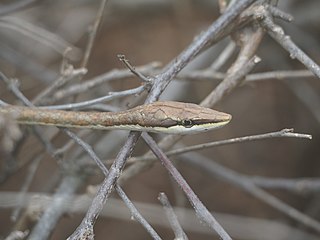
Colubridae is a family of snakes. With 249 genera, it is the largest snake family. The earliest fossil species of the family date back to the Late Eocene epoch, with earlier origins suspected. Colubrid snakes are found on every continent except Antarctica.
François Marie Daudin was a French zoologist.

Oxybelis aeneus, commonly known as the Mexican vine snake or brown vine snake, is a species of colubrid snake, which is endemic to the Americas.
Horsewhip or horse whip may refer to:

Ahaetulla, commonly referred to as Asian vine snakes or Asian whip snakes, is a genus of colubrid snakes distributed throughout tropical Asia. They are considered by some scientists to be mildly venomous and are what is commonly termed as 'rear-fanged' or more appropriately, opisthoglyphous, meaning their enlarged teeth or fangs, intended to aid in venom delivery, are located in the back of the upper jaw, instead of in the front as they are in vipers or cobras. As colubrids, Ahaetulla do not possess a true venom gland or a sophisticated venom delivery system. The Duvernoy's gland of this genus, homologous to the venom gland of true venomous snakes, produces a secretion which, though not well studied, is considered not to be medically significant to humans.

Oxybelis fulgidus, commonly known as the green vine snake or the flatbread snake, is a species of long, slender, arboreal colubrid snake, which is endemic to Central America and northern South America.
Vine snake can refer to several genera of snake in the taxonomic family Colubridae:

Gorgona is a Colombian island in the Pacific Ocean situated about 28 km (17 mi) off the Colombian Pacific coast. The island is 9 km (5.6 mi) long and 2.5 km (1.6 mi) across at its widest, with a maximum height of 338 m (1,109 ft) and a total area of 26 km2 (10 sq mi). Gorgona is separated from the continent by a 270 m (890 ft) deep underwater depression.

Oxybelis is a genus of colubrid snakes, endemic to the Americas, which are commonly known as vine snakes. Though similar in appearance to the Asian species of vine snakes of the genus Ahaetulla, they are not closely related, and are an example of convergent evolution.
Green snake or Greensnake or Green Snake may refer to:
Inkaterra is a Peruvian eco-tourism company. Founded in 1975 by José Koechlin, the company owns and operates hotels at Machu Picchu Natural Reserve, the southeastern rain forest of the Amazon in Puerto Maldonado, Tambopata, the Sacred Valley, and a restored 16th century manor at Cusco.

Oxybelis transandinus is a species of snake. The species was originally described in 2021 by Omar Torres-Carvajal, Mauricio Mejía-Guerrero and Claudia Terán from the Museo de Zoología of the Pontificia Universidad Católica in Ecuador.
Oxybelis rutherfordi, Rutherford's vine snake, commonly known as the Horsewhip in Trinidad & Tobago, is a species of snake. The species was originally described in 2020 by Robert C. Jadin, Christopher Blair, Sarah A. Orlofske, Michael J. Jowers, Gilson A. Rivas, Laurie J. Vitt, Julie M. Ray, Eric N. Smith & John C. Murphy.

Oxybelis brevirostris, Cope's vine snake, is a species of snake of the family Colubridae.
Oxybelis koehleri, Köhler's vine snake, is a species of snake of the family Colubridae.
Oxybelis microphthalmus, the thrornscrub vine snake, is a species of snake of the family Colubridae.
Oxybelis potosiensis, the Gulf Coast vine snake, is a species of snake of the family Colubridae.
Oxybelis vittatus is a species of snake of the family Colubridae.
Oxybelis wilsoni, the Roatan vine snake, is a species of snake of the family Colubridae.








